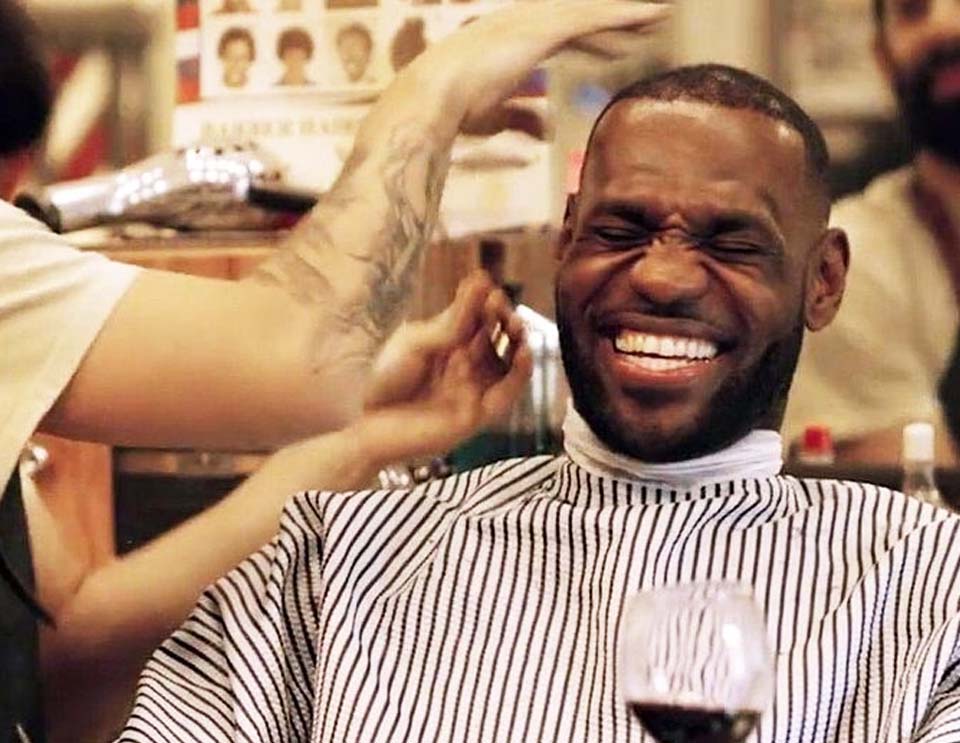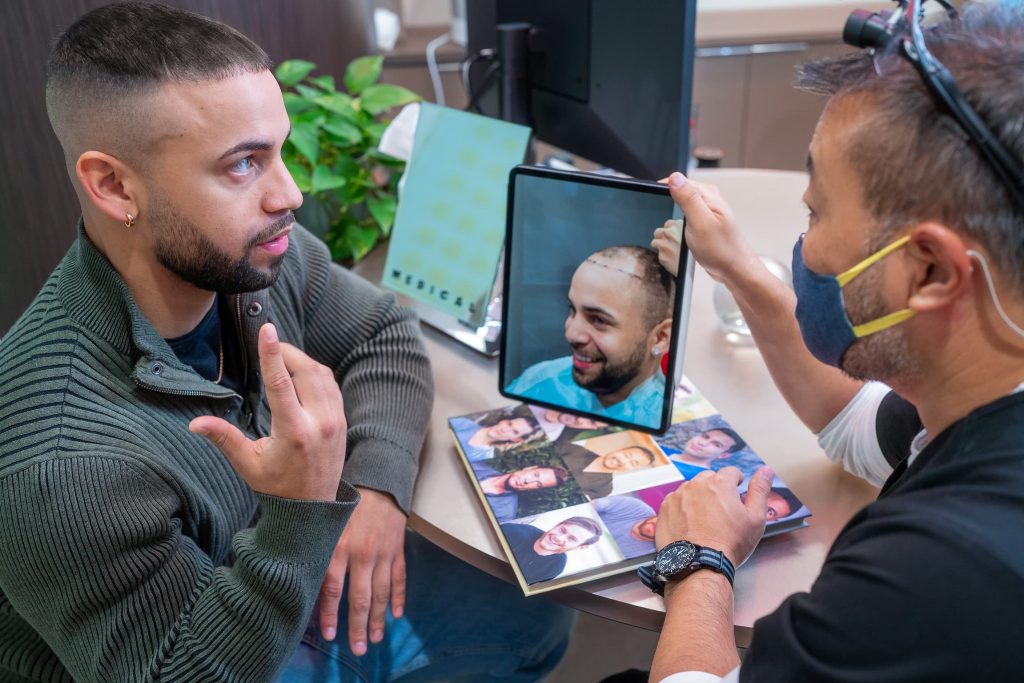
Photo from @kingljames
In the world of sports celebrities, few names carry more weight than LeBron James. James has been in the spotlight for more than two decades, beginning as a high-school phenomenon and taking multiple teams to NBA championships.
There’s no doubt that LeBron’s a future hall-of-famer, but fans and critics alike have a few questions about his hairline. Those questions can usually be summarized as “what’s going on up there?”
LeBron’s hairline might not be as crucial as his jump shot. Still, it’s a topic worth exploring, especially for those interested in hair restoration and the options available with today’s technology.
Let’s talk about what we’ve observed about LeBron’s hair throughout his career and speculate what he might be doing behind the scenes to keep it looking good in the spotlight.
Before we talk about what LeBron might have done to restore his hair via surgery or other treatments, let’s go over the various stages of his career and track his hairline journey from the start.
In 2003, LeBron entered the NBA at the age of 18, when his hairline looked strong as his scouting report for the Cleveland Cavaliers.
At worst, one might say that the young LeBron had a “mature hairline” that would be perfectly acceptable for any mature man but showed minimal thinning or receding at this time.
But by the time LeBron reached his early 20s, his hairline started to show some progression on the Norwood scale, losing definition and receding slightly with each season.
At this stage, it’s highly unlikely that LeBron was using any treatments to maintain his hairline, as these exact hair loss patterns are common for men of his age.
LeBron began to fulfill his prophecy as the best basketball player of the modern era as he won championships for the Miami Heat and the Cavaliers.
But while his career was thriving, his hairline was definitely taking some L’s.
Photographs from this era show diffuse hair loss across the entire frontal region of the scalp, with some minor thinning on the crown.
During this period, LeBron progressed from Norwood 1 or 2, moving into the 3 or 4 range on the scale. We can see the distinct difference in hair thickness and coverage between the frontal scalp region and the sides of the head, where little or no hair loss occurred.
The saga of LeBron’s hairline took some dramatic turns in recent years after he joined up with the Los Angeles Lakers.
While his hairline looks solid in commercials and movies like Space Jam 2, it showed some weakness at gametime when sweat and strain come into play.
In one memorable incident in 2019, Lakers teammate Anthony David alerted LeBron to a hairline crisis from the bench. The cameras clearly showed some major thinning and patchiness on the scalp.

It’s clear that LeBron has had ups and downs in the hair department over the years, with some extra help from surgery or various treatments.
But since the superstar hasn’t spoken openly about his hair restoration methods, we can only speculate what he might have done to reverse or maintain his hairline.
Here’s what we think LeBron may have done for his hairline based on the evidence at hand.
All signs point to a hair transplant when analyzing LeBron’s hairline throughout his career.
The most obvious indication of hair transplant is the restoration of the linear hairline that previously showed signs of patchiness and standard male-pattern balding in his 20s.
We can zoom in on photos to see that LeBron’s hairline was intentionally reconstructed with natural hair at some point in the early 2010s, following a period of advanced balding on the frontal region of the scalp.
Only a hair transplant could have been used to turn back the clock and reconstitute LeBron’s youthful hairline when he first entered the league as a young man.
The question isn’t whether LeBron underwent hair transplant surgery at some point, but rather what type of hair transplant he chose and how many hair follicles were taken from the donor area to attain that extra coverage and density on the recipient region.
It’s difficult to tell if LeBron chose the more traditional FUT “strip surgery” or FUE, the less invasive procedure.
Because LeBron doesn’t appear to have the signature linear scar on the back of the head from FUT and instead shows signs of light pattern “dots” on the donor region, we can safely guess that FUE was his procedure of choice.
Time and recovery are factors when considering celebrity hair restoration strategies, and FUE may have offered LeBron a more discrete surgical option with a faster recovery time.
This would help LeBron get back on the court faster and limit his time away from the game.
It’s also possible that LeBron had a session or two of Scalp MicroPigmentation, which is often used to help hide scarring on the donor area.
With a bank account like LeBron’s, we can only guess what types of alternative therapies he might have undergone over the years.
A hair transplant seems more than likely, but this doesn’t mean he avoided other forms of treatment such as low-level laser cap therapy, platelet-rich plasma injections, or even stem cell therapy to help promote hair restoration.
Athletes have the best doctors in the world to keep them in shape for game time, so it’s entirely possible that LeBron also went for the top-tier hair treatments available, even if they were considered more experimental at the time.
Apart from surgery and alternative therapies, it’s likely that ‘Bron has been doing some preventive measures to keep his hairline from further receding and protect the work done through his various procedures.
We must also address the possibility of LeBron using hair fibers, concealers, and other add-ons to create the illusion of natural hair on the scalp for on-screen appearances.
These products are more commonplace and advanced nowadays, used by men and women alike. For the length and quality of LeBron’s hair, keratin-based hair products can help fill gaps and create a fairly realistic appearance, even in HD!
The downside here, of course, is that even the best fillers don’t last long. It’s not out of the question that LeBron reapplies during halftime or before the post-game press conference.

LeBron has done a decent job at restoring and maintaining his hair over the years, and there are some takeaways that you may want to consider when navigating your own course of action.
Once again, FUT and FUE will be your best bet for full-on hair transplantation, just like LeBron has done over the years.
Keep in mind that FUT can be a “one-and-done” option for larger volumes of hair, while FUE is more of a “piece-by-piece” strategy that can facilitate multiple procedures.
We aren’t 100 percent certain whether LeBron went for FUE or FUT in his journey. In fact, he very well could have done both over a 20-year career.
No matter what, always consult directly with a hair restoration professional before jumping into either procedure since so many variables are at play.
Although we can’t be sure if LeBron has used medications or alternative therapies to address his hair loss, hair restoration experts agree that many treatments can be effective.
Topical Minoxidil and once-a-day Finasteride is the tried-and-true combination for preventive measures against hair loss, and both can be obtained quickly and affordably.
Scientific support isn’t available in advanced therapies like PRP, low-level laser, and stem cells. Furthermore, these treatments can add up quickly in cost and must be ongoing to be effective.
Remember: your hair restoration should take everything into account, including medication, surgery, or other treatments. Like LeBron needs a coach to win championships, you need a hair loss pro, like Jae Pak MD, to help you call the right plays.
It’s hard to say whether LeBron successfully navigated his hair loss journey, with a few snafus along the way. However, he appears to be in a good position now, with a strong head of hair late in his career.
We can learn some lessons from LeBron’s hair story, and most importantly, the guidance of a professional surgeon and clinical support is critical.
Team up with Jae Pak, MD, and our team today so that you can get back that confidence and take on the game of life like a champ.
Sources:
The phenotype of normal hairline maturation | NIH
Classification of Male-pattern Hair Loss | PMC
Low level laser therapy and hair regrowth: an evidence-based review | NIH
Speak with Jae Pak, M.D. today!
Request a Consultation